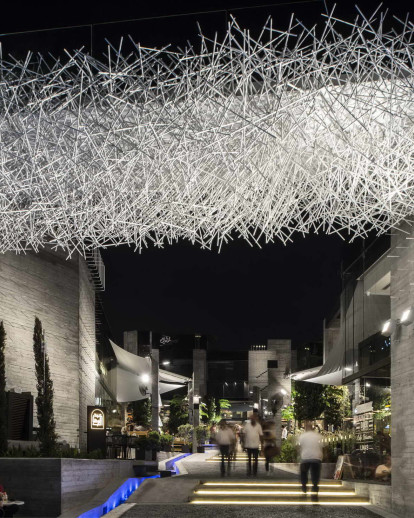Cluster H -
The Backyard, Hazmieh - Beirut
The human mind is forever inclined to order and organize objects into patterns in an attempt to create easily recognizable, navigable environments. However, unplanned human settlements clearly show more random configurations that cluster around various attractors; typically, natural resources and mercantile spaces. Beirut, displays such an unruly pattern. Being an ancient city it has fallen subject to the influence of numerous cultures and has altered itself to adapt to its occupiers. Layers have accumulated and recent wars compounded by explosive growth have seen it engulf the suburbs. The lack of proficient planning and a succession of conflicts have driven the residents and their city to become resourceful and creative. Beirut is in need of additional public spaces, parks, public transport, infrastructure and the like. Yet despite what would seemingly bring any city to its knees, this one, while clearly chaotic is surprisingly resilient. It is an authentic mess that adapts and sometimes operates fairly well. This unexpected contradiction is the basis of the Cluster H project located in Hazmieh, a neighborhood at the edge of Beirut.
Cluster H, popularly known as “The Backyard”, is the brainchild of 2 developers (Rabih Saba and Marwan Ayoub) who specialize in hospitality and build projects that incorporate primarily restaurants and bars. Their concept is based on adapting the mall model to an outdoor venue taking advantage of the mild Mediterranean weather and flora.
The Plan
The plan, learning from Beirut, attempts to materialize the paradox of ‘organized chaos’. A cluster of irregular polygons allows the building to adapt to the unusual lot form. The derived volumes and terraces interlock and overlap to accommodate the rising topography; they climb up 10 meters from south to north with ease. Ramps and steps make the climb fluid and exciting while augmenting visual interaction with the terraces and breaking down scale. This strategy reinforces the local voyeuristic culture of seeing and being seen. Water connects 3 ponds guiding visitors through the project to the sound of a flowing stream and cools the atmosphere while trees and plants complete the experience.
The Walls
Referencing the textured, aging quality of walls in Beirut, the concrete envelope of the buildings is left in “raw” condition with all its imperfections. This intentional “error” amplifies the paradoxical idea used in the plan and contrasts it with flush glazing that brings smoothness, plentiful light and reflections.
Typically, the steel rods used to hold the concrete formwork are sawed off and plastered over. Here they were removed, cleaned and painted, then re-planted on the façade as a form of “hairy” cladding recycling some of the waste and emphasizing the coarseness of the surfaces.
The Pedestrian Bridges
Made of thin 4mm steel plates sitting on an assemblage of reinforcement bars recuperated from site-produced waste, the bridges recycle steel that would have otherwise been discarded. This strategy saves energy and renders these features sustainable both ecologically and economically in addition to innovating on a structural level. Both experimental bridges were field tested with 4 and 5 tons of weight respectively to ensure the structural integrity of the randomized space frame principle used here for the first time. The 2 bridges create grand entrances that welcome and surprise the visitors upon arrival.
The Columns
The totem like columns are inspired by a Lebanese building practice; atop a newly built home, families often leave a number of columns with protruding steel reinforcement in anticipation of the construction of a future additional floor. This idea was altered and re-imagined in the form of multi-purpose columns that define the space of the terraces while hosting fans, lighting, planters, cameras, speakers, heaters, garbage cans and canopy supports.
The Benches
Beirut faces a serious lack of public spaces and the benches designed here are meant to provide a potential model of how private buildings and random city walls could become hosts to public seating and enhance the quality of civic life.
One bench was designed to accommodate a minimum of 2 people facing one another in a laid back position with the intent to promote interaction or relaxation while the other was designed to accommodate different user groups. Both adults of all sizes and children of different ages are accommodated.
The customized Lighting
Vertical steel tubing louvers are used to cover technical areas throughout the project. That same tubing occasionally extends as custom lighting for the planters or playfully snakes on a ceiling to illuminate a path. Varied configurations of the tube lights cap the roof terraces infusing some order to the ostensible unruliness. Below, the custom lights edging the various outlets hover like fireflies delineating boundaries.
Brutalism “re-mixed”
At Cluster H raw concrete is extensively used and large masses are clearly present yet fragmented. Glazing is extensive and steel features are slender and light. This is meant as a departure from 20th century brutalist structures that tended to emphasize heavy looking materials in bold geometric forms and small windows relative to other parts. Here, the scale was intentionally broken down and nature weaved in completing the transformation. The final result is our contemporary interpretation of a Mediterranean brutalism.
Architects: Bernard Mallat Architects + Walid Zeidan
Architectural team: Tamer Musharbesh, Mahmoud Charif, Michel Semaan, Chadi Dagher, Louis El Khoury.
Landscape Architect: IGA - Imad Gemayel
Lighting Design: Aartil – Majdi Hajjar
Location: Hazmieh - Beirut, Lebanon
Structural Engineer: Civil Minds - Anwar Antoun
Mechanical Engineer: Rabih Khairallah
Electrical Engineer: Naji Geha
Project Manager: Platinum Invest Holding
Client: Venture Group - Rabih Saba and Marwan Ayoub
Year: 2016
Winner of the crowd award at the LAA (Lebanese Architecture Awards)
Exhibited at the UIA congress in Seoul 2017
Photos by Ieva Saudargaite






























